Home Network Setup
-
So I know that many of us have different network needs and we all have our individual unique setups for our network, but I was curious to know what kind of place you have and how you have everything setup.
Mine is rather unique in that my part of it is actually a system composed of two different networks. There is also a third network involved, however the equipment at the main switching point is rather limited.
See, I live in a house with my parents and one brother. It's a back split house so it's technically 4 levels, but it's effectively only two as each level is only a half a level. On the "top" floor, there are 3 bedrooms and a bathroom. My parents use the master bedroom, my brother uses the one across the hall from my parents, and the one at the back of the house is being used as my mom's office. On the "main" floor, there is a front entrance/hall, a dining room, a living room, and a kitchen. In the "basement floor", there is a family room, back hallway, bedroom (mine) next to the bathroom and laundry room. Lastly, in the "sub-basement floor" there is a storage room, an L shaped room, a workshop/server room, and a fruit cellar. All of the lights and such can be turned on and off manually, however you can also tell one of a number of Google units throughout the house to turn stuff on and off as well. Everything including the smart thermostat is all 100% me wired and configured. It's great! There is also a decent sized front yard, and a decent sized backyard with a HUGE swimming pool.
Originally, it was just my father's network, which has existed in this location since about 2010. If a device can be hard wired, it is, and each device in each room wires to a central switching point where the modems are all located. The problem with this is that it's only a 15/10 VDSL line, which for my purposes, is rather slow.
The DSL network itself sports three different WAPs, which cover the entire house. There is one built into the DSL modem itself, which has 2.4GHz Wireless N (WiFi 4) and 5GHz Wireless AC (WiFi 5), however due to its location, only covers a limited area. There are two other 2.4GHz Wireless N (WiFi 4) WAPs in the house, which all have different network names, and are all tied together by a hard wired backhaul. This too creates many a problems for me as I often move between areas of the house, and have to manually make the switch when using that network.
There is also a second DSL line alongside it, which runs my brother's dedicated 50/10 VDSL line, which more or less just runs from the modem directly to his bedroom where all the magic happens. Then, alongside all that, there is my 940/50 cable line just for me and my equipment. It sports a 2.4GHz/5GHz Wireless AX (WiFi 6) system, which also has 3 different WAPs, however is a mesh network, which makes it work everywhere all as one big happy network with no slow or dead spots across the entire property, including the front and back yards. Just like the main DSL network for the house, everything that can be hard wired IS hard wired, and all the lines to all the devices come down to the same main switch point so that when I move out, I can move all the existing lines over to the DSL network for my parents.
This is my Grand Central Station... It's at the back of the L shaped room in the sub-basement where the electrical, phone/DSL lines, and cable line comes into the house for the shortest amount of wire for the DSL modems as possible. It is also where all the telephone lines for both the oldschool landline that my parents have for the house, and my VoIP line all come together to split out to all the jacks.
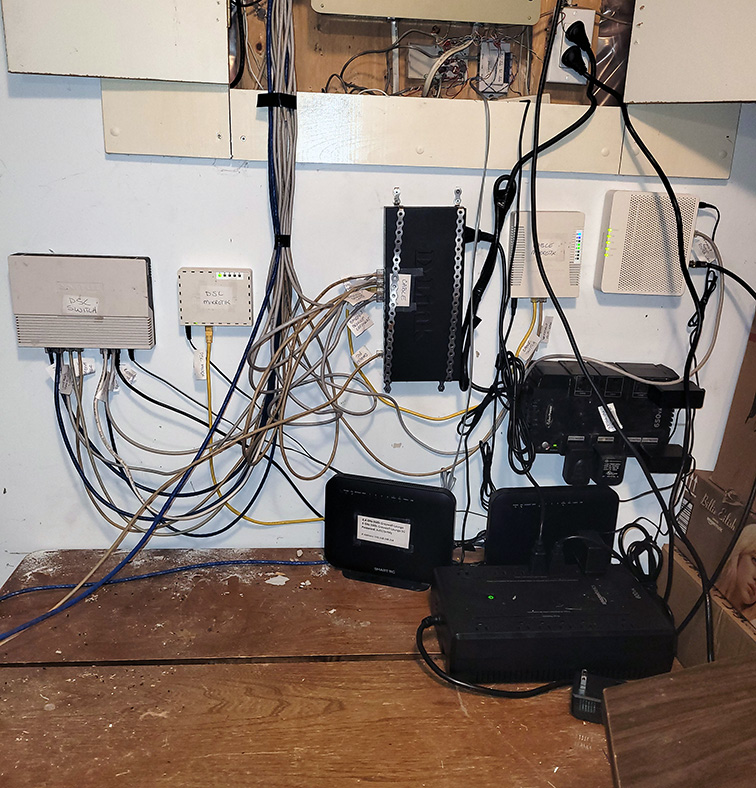
On the table, we have the two DSL modems. The main one on the left is the main DSL line for the whole house, and the one on the right is my brother's dedicated line. On the left of the wall, we have the 100 mbit switch that joins all the hard wired components of the network together and links it into the modem. The little box beside it is the actual router that does all the work and makes all the magic happen. It too is connected directly to the modem.
On the wall on the top right (the bigger white box) is the modem that makes my 940/50 cable line work. To the immediate left of that is the DHCP/VPN router for my network, and to the left of that is the big black 1000 mbit switch that joins all my hard wired equipment together. Below my modem and router on the wall is the UPS unit that runs the DSL network. It will keep the main hard wired guts of the network up and running in the event of a power failure for up to 18 hours without power. Lastly, the big black box in front of the modems on the table is the UPS unit that runs my cable modem, DHCP/VPN router, and 1000 mbit switch that joins everything together. You will also notice that my network is built alongside the existing network in such a way that everything can be moved over to the main network when I move out.
There are two lines that run from this point, across the sub-basement, and through a cold air return into the 1st level of the basement to the middle of the house. This is where my main wireless router is located, as it's central to the entire house. It's a TP-Link Archer AX20. It will soon be upgraded in favour of a router that supports a 10 gbit WAN port and WiFi 6E. One line runs from one of the ports on the modem to the WAN port on the router, and the other runs from the LAN1 port on the router down to the main switch that joins all the hard wired equipment together.
This is where it sits...
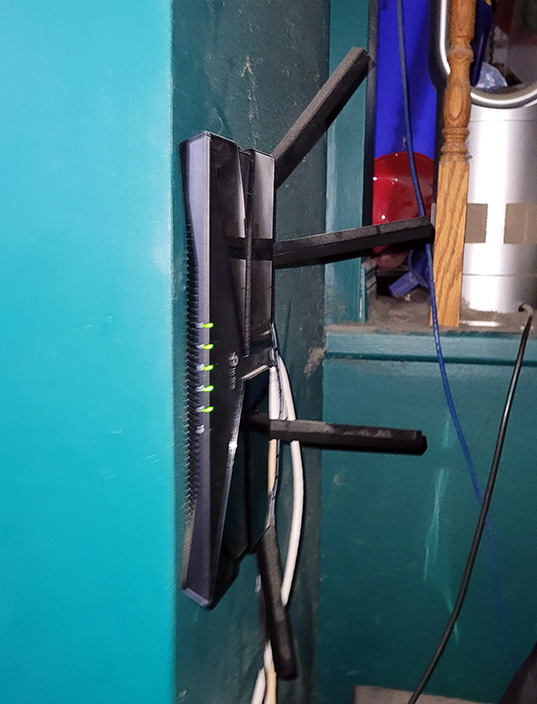
Then, the problem became that while this central point is good to get the signal decently to anywhere in the house, if I go to the front porch or backyard to have a cigarette or smoke a bowl, the signal starts to degrade badly, especially on the front porch if the front door is closed.
Enter the WiFi Mesh Extenders.... They connect via wireless to the main WAP and extend the signal to the are around it. You can switch from one WAP to another seamlessly, without even knowing it so that I can go all the way through the house without dropping even one packet or seeming to disconnect from my WiFi.
At the back of the room that the main WAP is in, there's a mesh extender in the back window Just inside the window the signal is excellent as it's in the same room as the main WAP, however due to the nature of the router being under the foundation wall, the signal does not extend into the backyard and around the pool area very well.... That's where this bad boy comes in...
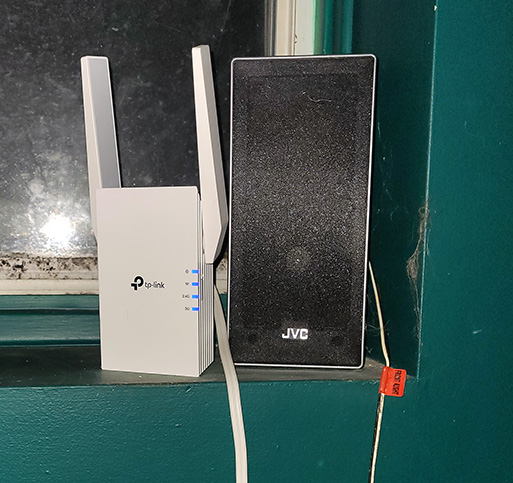
Lastly, at the front of the house in the living room near the front door where the signal from the main WAP is great, there is a second extender. This brings me decent WiFi on the front porch, in the front yard, and even in my van while smoking in my driveway with the engine idling to stay warm because it's winter in Canada.
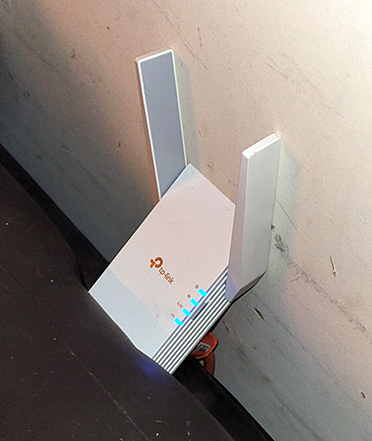
Both mesh extenders are TP-Link RE605X units... 1st Gen. Also, the main WAP/router, VoIP adapter, and main cordless phone base have a second UPS unit for them, and each of the mesh extenders is also on a UPS. The entire network will remain up and running for up to 5 days without power. How cool is that?
How does this setup rate in coverage and complexity to your setup?
-
@MrMazda you have quite a setup there! I used to have an elaborate setup, but nothing like you have.
One thing that intrigues me.. you have a UPS that can power your stuff for 5 days? What UPS is capable of that? I've had terrible luck with UPS storing power. I generate about 2000 watts of solar power, but STORING it is a problem. I would love to sell my unused electricity to the electric company, but have not figured out how to do that. Not having a way to get rid of excess electricity is a real problem... which recently resulted in some melted controllers, batteries, and inverters. I bought better equipment since then, so I won't have more incidents like that.
By the way, what are you doing with all that internet bandwidth? You aren't downloading PORN are you??? -
@lololulu19 Believe it or not, Amazon brand UPS units. When the only draw on them is very low, they last for a freakishly long amount of time.
As for the bandwidth, yes... Porn has a lot to do with why I need such a fast connection. I don't so much need the download speed as I do the upload speed, but the only way to get a decent upload speed is to have a retarded fast download speed as well.
-
@MrMazda yes.. most ISPs that offer extremely fast DOWNLOAD speeds offer only very low UPLOAD speeds. That doesn't affect me much, since everything I upload is removed within minutes or hours.
It was not easy to get ahold of that Hunter Biden video!
-
@MrMazda The real question ... does your family know that your side of the house is porn central?? LOL
-
@rnd256 exactly you nailed it ... LOL

Let's turn him in, hes hogging all networking ...
-
Thank you for telling us about your l-a-r-g-e home network setup, smart-home hacks, etc. I felt like a guest -- where is the hummus?
The picture with that wall of wires caused my testicles to briefly retract into my body cavity, but I took a deep breath, pushed them back out, and all's well.
-
-
@MrMazda
Absolute NoNo to put a wireless router in a basement. The router should be as high as you can get it close to where the outside connection comes in. That will dramatically change your wifi reception.Have you ever considered a seedbox? Apart from first immediate upload the seedbox will do all the subsequent downloading at the rest using huge bandwidth. Using a seedbox you will capture a high proportion of the download volume of those leeching though I suspect you have a high ratio anyway. Even if you are only bothered as to how fast you seed to the first leechers a seedbox will get your torrent off to an immediate (immediate) start.
The seedbox will of course download almost immediately any well seeded torrent. Using a downloader from the seedbox will improve your download speeds - though unless your brother is on the computer playing games and streaming TV at the same time that shouldn't really be an issue.
Also, of course, a seedbox is the best way to secure your privacy.
I know that you must know all this. But that is an awful lot of money to be spending on equipment and additional DSL lines that you don't need.
-
@raphjd You should see the pictures of what it used to look like before I started cleaning it up.... That is actually rather neat compared to what it was when I started cleaning it up.
-
@nix54 My brother and I shouldn't be able to affect each other. No part of either of our networks are joined in any way. Not even the backbone provider. He's on a 50/10 VDSL line and I'm on a 940/50 cable line with completely separate internal networks.
-
I should also mention that I have an elaborate setup for my trailer. The house that my trailer piggybacks off of is in the middle of nowhere with literally no neighbours at the very end of the line. The trailer is some 200 feet behind the house in the bush under a bunch of walnut trees.
And yes... I know... I still have some cleaning up to do. I was more concerned with getting everything working initially than I was about making it all pretty.
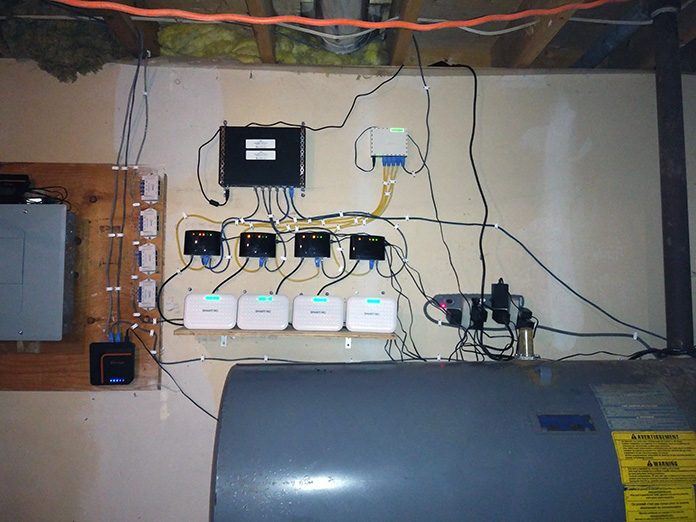
Simply put, I could only get legacy copper ADSL in the house, but because of the extreme distance from where the CO/SLAM are to where the modems are, I in theory didn't qualify to be able to get anything more than 1.5m/512k on a single line. This is just on the other side of the wall from where the lines run to the NID on the side of the house. I pimped up all the wiring to CAT5e all the way to the modems so that I could get each line up to 4m/800k.
I then got not one, but FOUR ADSL lines and put them together into a single line with 4x the speed. The big black box strapped to the wall is the DSL bonder. It's what connects through each of the 4 DSL modems into my provider, then puts the lines together into a single line. The little box to the right of it is the router/firewall/NAT for my network. The DSL bonder feeds the single line into this box, where it then connects out to all my equipment.
Below the bonder are 4 switches so that I can connect both the bonder and the router to each modem so that I have full remote access of everything across the network, even out in the trailer. The white boxes on the shelf below the switches are the modems for the 4 DSL lines. On the shadow board to the left of the internet equipment are the four POTS splitters for the four DSL lines, and the black box at the bottom to the left of that is the VoIP adapter, which makes the phone line out to the trailer work.
All of this then funnels down into a single cable that runs to the opposite corner of the basement to a switch that joins all the internal equipment together. There is a line that connects to this switch, runs out the outside wall, then disappears down into the ground and runs the 200 foot distance to my trailer while underground. It comes back out of the ground at the back of the trailer, where it then comes into the trailer and ends at a network jack on the wall inside the trailer where my WiFi router for the trailer connects to it so that everything from where the internet begins, all the way to the trailer itself is either underground or indoors, and it does not become wireless until it's inside the trailer.
For the record, this setup manages to get me able to pull 13mbit/3mbit at any time, in any weather, even in the trailer. It's not the fastest connection out there, but it's at least fast enough to watch scary movies (among other things) in 1080p HD and a glorious 5.1ch surround sound. This setup was originally inspired by all the people who told me that I would never be able to do such a thing in a trailer some 200 feet into the bush in the middle of nowhere, especially when that trailer acts as a giant Faraday cage for ALL radio signals. The WiFi works GREAT inside the trailer, as it does not become wireless at any point, in any way, until it is already inside the trailer.
Does this setup look as intimidating as some people tell me that it looks? It's super custom.
-
-
@flozen To be fair, much work has been done to the wiring in the house at the trailer to clean it up and make it proper, though it is on a home brewed battery backup that will fun for about 7 days without power and still never lose power, and that system also powers the WAP in the house, so in the house you NEVER don't have WiFi.
In the trailer, there is no battery backup for anything, however I do have and old car I have modified to effectively serve as a small generator powerful enough to run my entire trailer in the event of a power outage, and since the network wiring all the way into the trailer is on battery backup, I'm never without internet or WiFi there either. A full tank of gas lasts about 49 hours.
Needless to say, when I'm at the trailer, I don't camp, I glamp. I have power for all my electronics one way or another, I have heat, a way to cook (propane stovetop/oven), and a way to keep stuff cold (propane fridge), working internet fast enough to stream video content in HD, good WiFi, and a decent sound system I can crank full blast until an ungodly hour of the morning without anyone hearing it. It also comes with an 8 foot wide fire pit big enough to have everything from small campfires, to giant bonfires of furniture (which I have pictures of to prove). Last summer the trailer got an upgrade of a well, well pump, and septic tank with weeping bed. What more does one need to glamp properly? Haha
On a side note, the well pump for the trailer won't work if the hydro (electric) service to the trailer is out, but everything else inside the trailer will. No power means no running water for the trailer, but not the end to my ability to drop a deuce without having to walk through the tundra to the house anymore.
-
@MrMazda said in Home Network Setup:
@flozen In the trailer, there is no battery backup for anything, however I do have an old car I have modified to effectively serve as a small generator
Please, please let it be a Mazda.
